Brightness and Contrast Ratio
For the brightness, contrast, and color accuracy tests we depend on the hardware colorimeter and software to help calibrate the displays. As previously stated, we use a Monaco Optix XR (DTP-94) colorimeter and Monaco Optix XR Pro software. The software and hardware help users to get more accurate color from their displays. Before we get to the calibrated results, we took a quick look at the range of brightness and contrast without any color calibration.
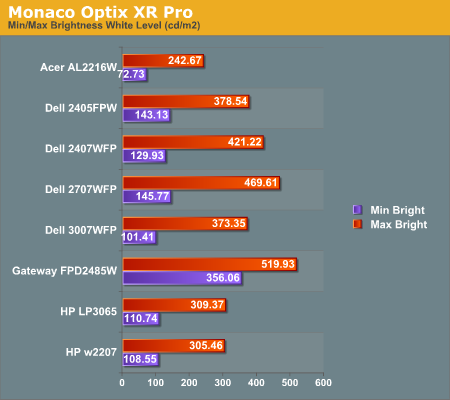
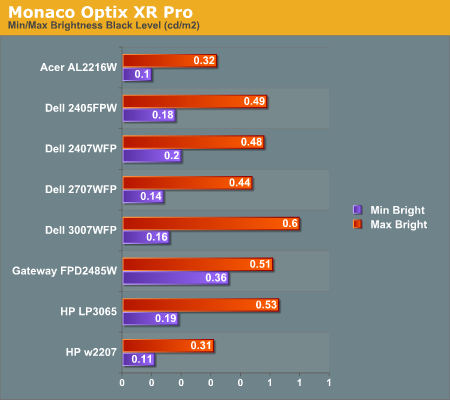
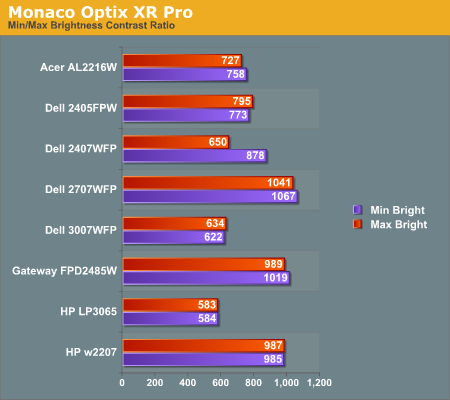
In the past we have seen LCDs that crank up the brightness level in order to increase the contrast ratio, but it's good to see that HP didn't go that route with the w2207. A maximum brightness level of 300 nits is pretty reasonable, and we don't see much reason to go beyond that. In practice, we tend to prefer a brightness level of around 200 nits, though others may prefer slightly brighter or darker. The HP w2207 can accommodate pretty much any desired brightness setting, and it does so while maintaining its exceptional ~1000:1 contrast ratio. That's one more item that sets it apart from the less-expensive Acer 22" LCD.
Color Accuracy
The problem with calibrating a display is that it doesn't help all applications. Specifically, the video overlay used when watching DVDs or other movies completely bypasses any color profiles, so you are stuck with the uncalibrated colors. Playing games and Windows Vista may also use the default color options - though in the case of the latter it's more a problem of determining how to set up your color profile properly. It is possible to tweak things somewhat on many LCDs using the OSD, but the amount of color correction that can be done via the OSD pales in comparison to color correction tables, and some LCDs (the Dell 3007WFP and HP LP3065 for example) are unable to adjust anything but brightness outside of software. Ideally, we would like to see video drivers begin to apply color profiles to all output - office applications, movies, games, or anything else.
For uncalibrated color accuracy, we adjusted the brightness as well as the contrast and colors (where applicable) using a "calibrate by eye" chart and the OSD controls. Also remember that color accuracy can vary from panel to panel even within the same model, and the results we are reporting are only from testing a single LCD. During testing, Monaco Optix XR Pro sends 24 color patches to the display with the colorimeter measuring the resulting values. The difference between what is requested and what the LCD actually shows is known as Delta E, with lower values being better. Any score less than one is basically "perfect" - the naked eye is not going to be able to tell the difference - and scores less than 2.0 are nearly perfect.
Ideally, you would want all of the tested colors to have a Delta E of less than 1.0, but almost no one is likely to have problems with anything scoring below 2.0. From 2.0 to 4.0, most people still won't notice the slight inaccuracies in the color palette, but when comparing displays side by side differences may be apparent - multimedia professionals in particular would prefer something better. Anything above 4.0 begins to represent a more significant deviance, and numerous scores above 6.0 will almost certainly be noticeable by just about anyone using the display. Consistency is also important, so a display that has very good scores overall but with high spikes on some colors may actually be less desirable than a display with a slightly higher but more consistent average Delta E. Note also that fluctuations of as much as one point in Delta E are possible during a short amount of time. It generally takes as much as 30 minutes for a display to warm up after it's first powered on, and all of our calibration and testing is performed after the displays have been running for at least one hour with the screensaver disabled.
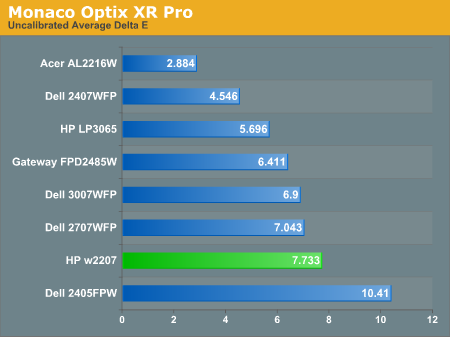
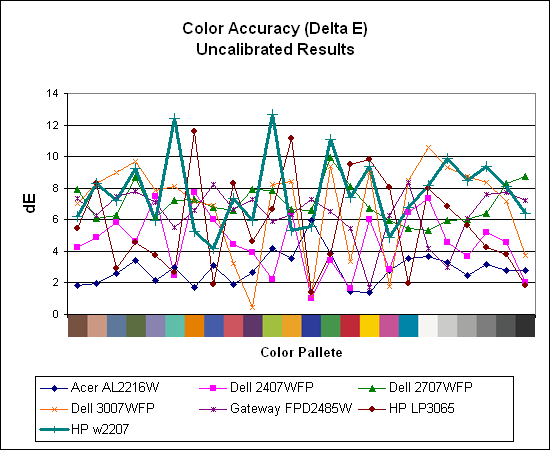
Without any form of color correction, the color accuracy of all of these displays is generally mediocre. The human eye will compensate quite a bit for differences between displays, so for most people even an average Delta E of 6.0 isn't going to be terrible. The HP w2207 rates a pretty poor 7.7 before calibration, besting only the two year old Dell 2405FPW. There are also quite a few spikes, with several colors having a Delta E of greater than 10.0. If you don't have color calibration equipment and you depend on accurate colors, the w2207 probably isn't the best choice. In fact, out of all of the LCDs we've tested so far, only the Acer AL2216W generates an uncalibrated Delta E result of less than 3.0. That particular display has other drawbacks, and we really wish that more of the displays could generate acceptable uncalibrated Delta E results.
For the brightness, contrast, and color accuracy tests we depend on the hardware colorimeter and software to help calibrate the displays. As previously stated, we use a Monaco Optix XR (DTP-94) colorimeter and Monaco Optix XR Pro software. The software and hardware help users to get more accurate color from their displays. Before we get to the calibrated results, we took a quick look at the range of brightness and contrast without any color calibration.



In the past we have seen LCDs that crank up the brightness level in order to increase the contrast ratio, but it's good to see that HP didn't go that route with the w2207. A maximum brightness level of 300 nits is pretty reasonable, and we don't see much reason to go beyond that. In practice, we tend to prefer a brightness level of around 200 nits, though others may prefer slightly brighter or darker. The HP w2207 can accommodate pretty much any desired brightness setting, and it does so while maintaining its exceptional ~1000:1 contrast ratio. That's one more item that sets it apart from the less-expensive Acer 22" LCD.
Color Accuracy
The problem with calibrating a display is that it doesn't help all applications. Specifically, the video overlay used when watching DVDs or other movies completely bypasses any color profiles, so you are stuck with the uncalibrated colors. Playing games and Windows Vista may also use the default color options - though in the case of the latter it's more a problem of determining how to set up your color profile properly. It is possible to tweak things somewhat on many LCDs using the OSD, but the amount of color correction that can be done via the OSD pales in comparison to color correction tables, and some LCDs (the Dell 3007WFP and HP LP3065 for example) are unable to adjust anything but brightness outside of software. Ideally, we would like to see video drivers begin to apply color profiles to all output - office applications, movies, games, or anything else.
For uncalibrated color accuracy, we adjusted the brightness as well as the contrast and colors (where applicable) using a "calibrate by eye" chart and the OSD controls. Also remember that color accuracy can vary from panel to panel even within the same model, and the results we are reporting are only from testing a single LCD. During testing, Monaco Optix XR Pro sends 24 color patches to the display with the colorimeter measuring the resulting values. The difference between what is requested and what the LCD actually shows is known as Delta E, with lower values being better. Any score less than one is basically "perfect" - the naked eye is not going to be able to tell the difference - and scores less than 2.0 are nearly perfect.
Ideally, you would want all of the tested colors to have a Delta E of less than 1.0, but almost no one is likely to have problems with anything scoring below 2.0. From 2.0 to 4.0, most people still won't notice the slight inaccuracies in the color palette, but when comparing displays side by side differences may be apparent - multimedia professionals in particular would prefer something better. Anything above 4.0 begins to represent a more significant deviance, and numerous scores above 6.0 will almost certainly be noticeable by just about anyone using the display. Consistency is also important, so a display that has very good scores overall but with high spikes on some colors may actually be less desirable than a display with a slightly higher but more consistent average Delta E. Note also that fluctuations of as much as one point in Delta E are possible during a short amount of time. It generally takes as much as 30 minutes for a display to warm up after it's first powered on, and all of our calibration and testing is performed after the displays have been running for at least one hour with the screensaver disabled.


Without any form of color correction, the color accuracy of all of these displays is generally mediocre. The human eye will compensate quite a bit for differences between displays, so for most people even an average Delta E of 6.0 isn't going to be terrible. The HP w2207 rates a pretty poor 7.7 before calibration, besting only the two year old Dell 2405FPW. There are also quite a few spikes, with several colors having a Delta E of greater than 10.0. If you don't have color calibration equipment and you depend on accurate colors, the w2207 probably isn't the best choice. In fact, out of all of the LCDs we've tested so far, only the Acer AL2216W generates an uncalibrated Delta E result of less than 3.0. That particular display has other drawbacks, and we really wish that more of the displays could generate acceptable uncalibrated Delta E results.










43 Comments
View All Comments
Bjoern77 - Thursday, August 2, 2007 - link
You'll find that Monitor to be very popular in Europe, specially Germany due to it's low price.Well - low price compared to other monitors.
EG, the Dell 2407 WFP HC is supposed to cost around 1000$ here, the older version is on "sale" for about 850$. If i see the US-Prices for tfts...ouch. Same goes for a lot of other monitors. The HP is the first i noticed on the us markt which seem to be on a European price level, which, i assume, is at least 25% higher.
trajan - Wednesday, August 1, 2007 - link
The one thing I immediately noticed from the review was the difference between the Gateway 24" and the Dell 24". I've never seen these ratings before -- it looks like in most catagories the Gateway is superior. Am I reading this right? I thought the Dell was the hands down 24" champion!JarredWalton - Wednesday, August 1, 2007 - link
The Gateway has a brighter backlight, but in most other areas I felt the 2407WFP and the FPD2485W were about the same. I prefer the appearance of the Dell LCD over the Gateway LCD, and the extremely bright backlight on the Gateway means that you usually have to spend more time tuning things if you don't want to be blinded. If you had them both set to the same intensity, however, I don't think most people would be able to tell the difference between the panels.nilepez - Wednesday, August 1, 2007 - link
I'm still using an old CRT, and I don't know why one would compare at a monitor with a max resolution of 1600x1050 to a CRT that was likely capable at least 1800x1440 and 1920x1440 was fairly common. Mine goes higher, but the refresh rate is too slow at that point.I personally think that the 24" displays are the first ones that are comparable to 21" monitors. The 22" monitors are more comparable to some of the better 19" monitors (though I suppose there may have been crappy 21" monitors with a max usable res of 16x12.
I personally wish I could justify the 30" monitors, but at current prices, I'd be better off going dual monitor with 2 24" models (desktop space is king :) )
Jodiuh - Wednesday, August 1, 2007 - link
Have you seen a nice 20in S-IPS next to your old CRT? I have an older 19in CRT and it pales in comparison to the NEC or Dell panels.yyrkoon - Thursday, August 2, 2007 - link
I had a professional grade 21" CRT next to my 19" WS LCD, and I have to say that the LCD is much, MUCH better for vibrance/image sharpness. The LCD to boot was also 1/5th-1/6th the cost of the 21" CRT . . .nilepez - Wednesday, August 1, 2007 - link
Probably not, given that most stores carry crappy monitors, but I'm really not willing give up real estate to move to a flat screen.even at 1920x1440, I feel cramped if I'm I've got more than 2 instances of jedit open (and I'd really like to have 4, and occasionally more, in most cases).
24" monitors are the smallest monitors with sufficient resolution, although even then, my desktop shrink by almost 20%.
Great Googly Moogly - Thursday, August 2, 2007 - link
Well, it seems you're forgetting about pixel pitch. Those 1920x1200 24" have quite a high pixel pitch. Certainly a 20.1" LCD with a 1600x1200 resolution is better for you?The only LCDs with a decent pixel pitch not stuck in 1991 (seriously) are the 1280x1024 17" (too small, physically, though), 1600x1200 20.1" and the 2560x1600 30".
The new 1920x1200 26-27" are really atrocious, and the most popular 1680x1050 22" is not up to my standards either--hence the main reason (out of many) why I'm still on an iiyama CRT. And if this trend is still going in a few years, we'll have 720p 40" computer monitors. And everyone will love them.
So sick and tired of computer display tech going steady backwards since the 90s.
jc44 - Thursday, August 2, 2007 - link
To be fair 2001 was a good year for displays - IBM built the first T221s (24" 3840x2400) :-) 2006 was not such a good year - IBM ceased production of T221s with nothing even vaguely equivalent in sight from anybody :-(strikeback03 - Thursday, August 2, 2007 - link
Didn't they cost somewhere around $30,000? no wonder they disappeared.